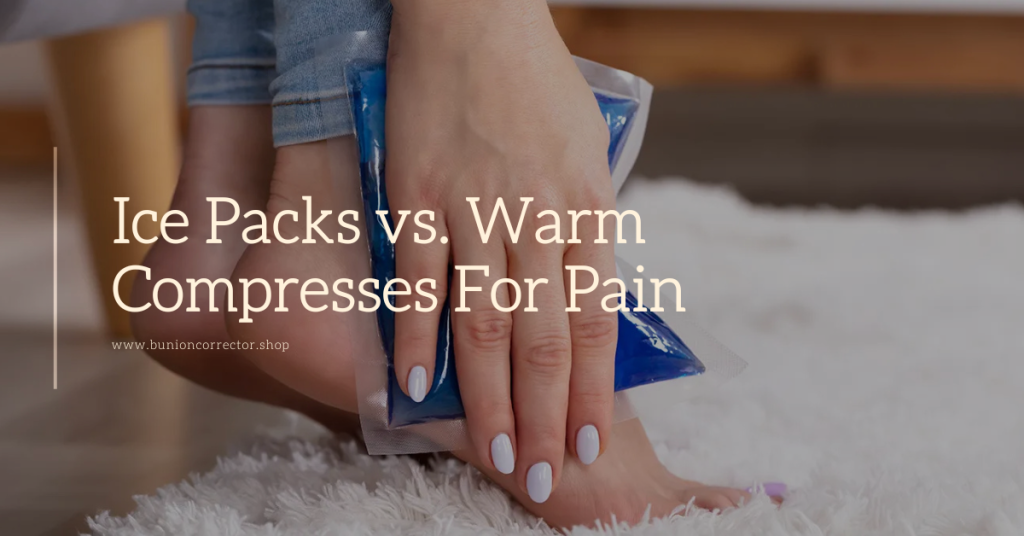Pain relief is a common concern for people with various conditions, whether muscle soreness after a workout, a sprained ankle, or chronic discomfort from arthritis. Regarding managing pain, two popular methods often come to mind: Ice Packs vs. Warm Compresses. But how do you know which one to use? In this blog post, we’ll break down the differences between Ice Packs vs. Warm Compresses and explain when to use each for optimal pain relief.

Understanding the Basics: Cold Therapy vs. Heat Therapy
Before diving into specific use cases, it’s essential to understand the general benefits of Ice Packs vs. Warm Compresses.
What is Cold Therapy (Cryotherapy)?
Cold therapy, commonly called cryotherapy, involves applying ice or a cold pack to an injury or area of pain. The freezing temperature constricts blood vessels, reduces blood flow to the area, and minimizes swelling and inflammation. It benefits acute injuries like sprains, strains, or post-surgery recovery.
What is Heat Therapy?
Heat therapy works by applying warmth to the body, which helps to dilate blood vessels, increase blood flow, and relax muscles. Warm compresses are great for soothing stiff joints, chronic pain, and tension. Heat can provide comfort and relief by loosening tight muscles and improving tissue flexibility.
When to Use Ice Packs for Pain
Ice therapy is best suited for fresh injuries or conditions that involve swelling or inflammation. Here are some situations where ice packs are typically more effective:
1. Acute Injuries
- Ice is the go-to treatment for immediate injuries, such as sprains, strains, and bruises. These injuries cause blood vessels to break and tissues to become inflamed. Applying ice can reduce swelling, numb the area, and prevent further tissue damage.
How to Use Ice Packs for Acute Injuries:
- Apply ice as soon as possible after the injury occurs.
- Limit each application to 15-20 minutes to avoid skin damage.
- Wait an hour between sessions to allow the skin to return to average temperature.
- Always use a barrier between the ice pack and your skin, such as a thin cloth or towel.
2. Swelling and Inflammation
- Conditions like tendonitis, bursitis, or overuse injuries can cause painful inflammation in muscles or joints. Ice packs can help by numbing the area and reducing swelling, making it easier to move without discomfort.
Tip:
- Cold therapy is most effective within 48 hours of an injury or flare-up. After that, consider switching to heat therapy for long-term relief.
3. Post-Workout Muscle Soreness
- Many athletes or active individuals use ice packs after intense workouts to reduce muscle soreness. Cold treatment can help prevent delayed onset muscle soreness (DOMS) by limiting blood flow and slowing inflammation.
When to Use Warm Compresses for Pain
On the other hand, heat therapy is your friend when you’re dealing with chronic pain or muscle tension. Warm compresses help relax and soothe muscles, making them ideal for specific conditions:
1. Chronic Pain and Stiffness
- For people suffering from chronic conditions like arthritis or fibromyalgia, applying heat can help ease the stiffness that occurs with these long-term issues. Heat increases blood flow to the affected area, delivering oxygen and nutrients that help tissues repair.
How to Use Warm Compresses for Chronic Pain:
- Use heat for 15-20 minutes at a time, depending on the severity of the pain.
- Avoid applying heat directly to open wounds or areas with poor circulation.
- Moist heat, like a warm bath or steamed towel, can penetrate deeper into tissues than dry heat.
2. Muscle Aches and Cramps
- Whether it’s a sore back from sitting too long or menstrual cramps, heat is great for soothing muscle tension and spasms. Warm compresses can help reduce discomfort and improve flexibility by relaxing the muscles.
Tip:
- A warm bath or shower can be a simple and effective way to apply heat therapy to larger areas of the body. Adding Epsom salts may also provide additional relief.
3. Joint Pain and Stiffness
- If you suffer from stiff joints, heat therapy is particularly effective. Conditions like osteoarthritis or even simple stiffness from sleeping in an awkward position can be alleviated with heat. The warmth helps lubricate stiff joints, making it easier to move.

Ice Packs vs. Warm Compresses? How to Choose the Right Therapy
Knowing when to use ice and when to use heat can be tricky. Here’s a simple rule of thumb to follow:
Use Ice When:
- You have a new injury (within 48 hours).
- You’re experiencing swelling or inflammation.
- You want to numb pain quickly.
Use Heat When:
- You have chronic pain or stiffness.
- You’re dealing with muscle tension or cramps.
- You want to increase blood flow to promote healing.
Combining Both Therapies: The Contrast Method
- Alternating heat and cold therapy can benefit specific injuries or chronic conditions. This technique is known as the contrast method. Start by applying an ice pack for 10-15 minutes, followed by a warm compress for another 10-15 minutes. This helps reduce inflammation while also promoting blood flow and flexibility.
Essential Safety Tips for Using Ice and Heat
Whether you’re using Ice Packs vs. Warm Compresses therapy, it’s essential to follow some basic safety guidelines to avoid injury:
For Ice Therapy:
- Don’t apply ice directly to the skin. Always use a barrier like a cloth or towel.
- Limit each session to 15-20 minutes to avoid frostbite or skin irritation.
- Don’t use ice on areas with poor circulation, such as feet or hands, if you have conditions like diabetes.
For Heat Therapy:
- Be cautious not to use heat on fresh injuries, as it can increase inflammation.
- Always test the temperature of heating pads or compresses to prevent burns.
- Don’t use heat on open wounds or if you have impaired sensation (for example, if you have diabetes or have nerve damage).
Conclusion: Finding What Works Best for You
Ice Packs vs. Warm Compresses have their benefits depending on the type of pain or injury you’re experiencing. While ice is best for acute injuries and inflammation, heat works wonders for chronic pain and muscle stiffness. Always consider the nature of your pain when deciding which therapy to use, and remember that you can sometimes combine both methods for enhanced relief. If your pain persists or worsens, consult a healthcare professional to ensure you’re treating the underlying issue properly.